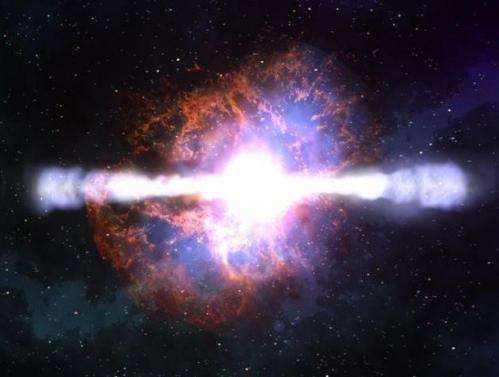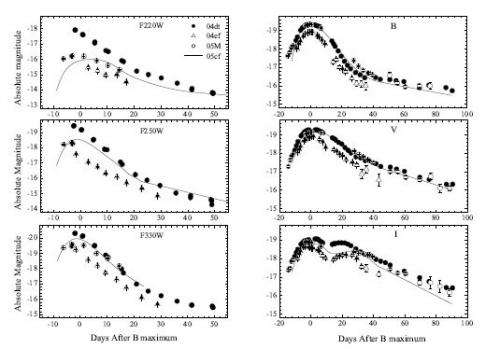Inconstant supernovae?

Given the importance of Type 1a supernovae as the standard candles which demonstrate that the universe’s expansion is actually accelerating – we require a high degree of confidence that those candles really are standard.
A paper released on Arxiv, with a list of authors reading like a Who’s Who in cosmology and including all three winners of this year’s Nobel Prize in Physics, details an ultraviolet (UV) analysis of four Type 1a supernovae, three of which represent significant outliers from the standard light curve expected of Type 1a supernovae.
Some diversity in UV output has already been established from observing distant high red-shift Type 1a supernovae, since their UV output is shifted into optical light and can hence be observed through the atmosphere. However, to gain detailed observations in UV, you need to look at closer, less red-shifted Type 1a supernovae and hence you need space telescopes. These researchers used data collected by the ACS (Advanced Camera for Surveys) on the Hubble Space Telescope.
The supernovae studied were SN 2004dt, SN 2004ef, SN 2005M and SN 2005cf. SN 2005cf is considered a ‘gold standard’ Type 1a supernovae – while the other three show considerable diversion from the standard UV light curve, even though their optical light output looks standard.
The researchers also looked at a slightly larger dataset of UV supernovae observations made by the Swift spacecraft – which also showed a similar diversity in UV light, that was not apparent in optical light.
This is a bit of a worry, since the supernovae dataset from which we conclude that the universe is expanding is largely based on observations in optical light which, unlike UV, can make it through the atmosphere and be collected by ground-based telescopes.

Nonetheless, if you are thinking that three outliers isn’t a lot – you’d be right. The paper’s aim is to indicate that there are minor discrepancies in the current data set upon which we have built our current model of the universe. The academic muscle that is focused on this seemingly minor issue is some indication of the importance of isolating and characterising the nature any such discrepancies, so that we can continue to have confidence in the Type 1a supernovae standard candle dataset – or not.
The researchers acknowledge that the UV excess – not seen at all in SN 2005cf, but seen in varying degrees in the other three Type 1a supernovae – with the most pronounced difference seen in SN 2004dt – is a problem, even if it is not a huge problem.
As standard candles, Type 1a supernovae (or SNe1a) are key to determining the distance of their host galaxies. A higher than expected UV flux in some SNe1a could enhance their brightness in visible light (in cases where the unexpectedly bright UV is red-shifted into unexpectedly bright blue light). Such SNe1a would then be picked up in ground-based SNe1a sky surveys as misleadingly bright SNe1a – and their host galaxies would be determined as being closer to us than they really are.
The researchers call this another possible systematic error within the current SNe1a-based calculations of the nature of the universe – those other possible systematic errors including the metallicity of the supernovae themselves, as well as the size, density and chemistry of their host galaxy.
The key question to take forward now is what proportion of the total population of SNe1a in the universe might have this high UV flux. To answer that we will need to get more space telescope data.
More information: Wang et al. Evidence for Type Ia Supernova Diversity from Ultraviolet Observations with the Hubble Space Telescope.
Source: Universe Today




















